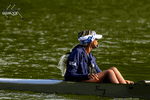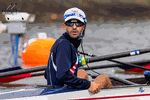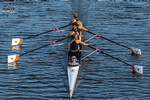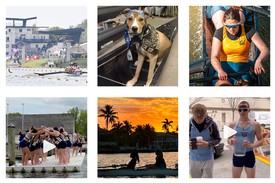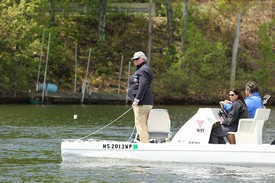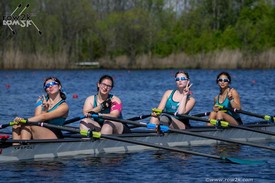In the Driver's Seat, with Charley Coffman
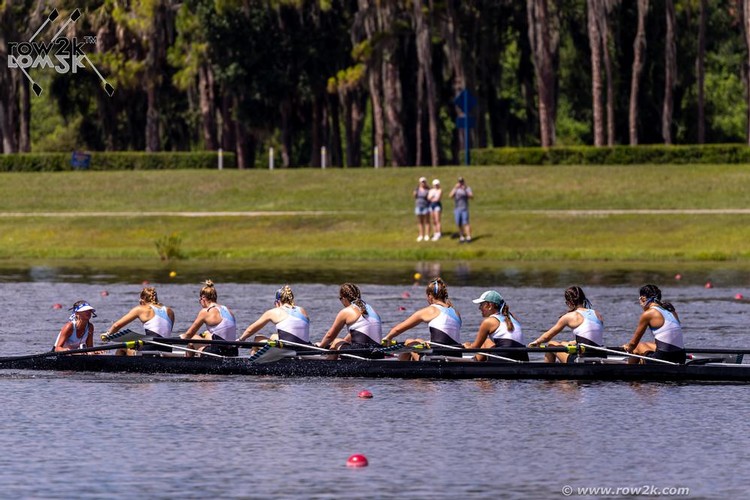
Next up In The Driver's Seat--where we hear from the folks who keep the shells straight and the crews on target--is coxswain Charley Coffman.
She coxes at DC National Boat Club, where she led her crew to the team's first ever appearance in the Women's Eight at Youth Nationals in 2023.
Charley did not start coxing until her sophomore year of high school, but proved to be a quick study and recently committed to Washington to drive for the Husky Men.
Let's hop In The Driver's Seat with Charley:
row2k - Give us your top three essentials for being ready on Race Day:
Charley Coffman - Mental preparation, race planning, and pre-race communication.
Mental Preparation. Staying mentally composed and present is not only crucial for my performance, but also for the rowers'. As a coxswain on race day, there are a million logistical things going through my mind. Where is my bow number? Is all of our hardware tight? Are we on time to launch? It gets easy to lose your composure if you are focusing on anything but the present.
As the coxswain, you are the unifying force in the boat who needs to display a calm demeanor, even if you aren't always feeling that way. The crew really does mirror the coxswain's energy, which is why it is so important to instill a sense of calm, especially in that time leading up to launching. Panic and anxiety has just as much of a physical effect on athletes as it does mentally. One tradition I started putting in practice before races was guiding a meditation for my boat to center ourselves. I created a rowing specific guided meditation which involves breathing exercises and affirmations to remind my crew and myself that we are physically and mentally prepared for the race ahead.

Race Planning Every coxswain has a different approach when it comes to creating a race plan. My team has a general starting sequence, and plans for 2000m races. I tend to spend most of my time planning the focuses and how I would like to make technical calls during the race.
I always say this part of the race planning begins during practice. I like to take notes during tech days and pieces to get a good understanding of my crew and what works best for them. Every crew is different, so personalization is key in the calls I like to make. You don't need to script out everything you want to say during a race, because races are not that straightforward. Staying attentive and detail oriented in the practices leading up to a race is most important and will have you more than ready on race day.
Pre-Race Communication The coxswain is the line of communication between the coach and the rowers. I find it helpful to run through my race plan ahead of time with my coach, as well as with my rowers, especially when it comes to courses that are particularly steering heavy. That mutual understanding is incredibly important in terms of trust on the water.
Races are often unpredictable, requiring the coxswain to make split second decisions based on the boats around you. It is impossible to predict every single scenario that could come up during a race, but I like to talk through some of them with my coach to make sure we have a mutual understanding of how I can best lead my crew through possible situations. It is important to be reliable, not only in the eyes of your coach, but also to your crew. I know that when we hit the water my crew trusts my judgment which allows us to keep composure when something unexpected happens.

row2k - What is your favorite drill to run with your crews? Any tips on how to the drill well, for maximum effectiveness?
Charley Coffman - One of my favorite drills to run at practice and one that I find myself running often is feet-out rowing. This drill emphasizes staying connected at the finish, as well as the blade work because the blade work needs to be precise to maintain balance.
When running this drill, I find it effective to make calls relating to the upper body and core. During the finish, the rowers need to engage their lower abs and sit up tall at the finish in order to keep a balanced boat. I also call for them to maintain pressure on the footplate all the way through the finish, to make them conscious of having an effective stroke length.
row2k - What's some of the best coaching advice you've received about your coxing?
Charley Coffman - My coach, Maxim Goohs, is truly my role model in terms of coxing and was the reason I fell in love with the position so much. A habit that a lot of young coxswains develop is a desire to scream for the entirety of a piece or race. Trust me, I was more than guilty of this. Your voice is a tool, and the tone sets a rhythm. Rowers will start to tune you out if your voice is consistently at a loud volume for the entire race.
I sent Maxim a recording of mine where I basically sounded like a drill sergeant, and he told me, "One way you know you can tell you're speaking too much is if you are out of breath. The only time you should be out of breath is the last 100 meters. Slowing it down, having composure. It's a matter of speaking like you're in control of the situation instead of the situation being in control of you." This advice really taught me that it doesn't just matter what you say, but how you say it which is so influential.

row2k - What is a mid-race call or move that you've made that you'll remember for the rest of your life? If so, what did it involve and how did you call it? Charley Coffman - I always make it a point to create personalized calls for the rowers in my boat to keep them engaged and motivated in a personal way. I actually keep a list in my notes app of all the calls I am particularly proud of, but a call I will remember for the rest of my life is one I called during the Schuylkill in 2021, my second ever head race. As a novice coxswain, head races were honestly a little intimidating for me, so I had actually gotten to the race site that day two hours before I needed to be there so I could walk the entire course, and take notes on the bridges, turns, and how other crews approached different points in the race. As a novice with not too much steering experience, I learned that I needed to hug the buoys on my port side to keep the best and most efficient line.
Fast forward to the race: my novice girls 8 started off very strong, already overtaking a crew pretty soon out of the Strawberry Mansion Bridge. We had asserted our position in the right place relative to the buoys, so all we needed to do was hold our ground through the Columbia Ave Bridge to be in the best place possible to take the turn out of that bridge. The issue was that there was another crew that was about a boat length in front of us that we weren't moving on and which held the line we needed.
I made the judgment that we had just enough space to make a move that, if we got it right, would have us overtake that crew about 10 strokes before the bridge. It was risky, but I had to trust my gut. I got my crew pumped and called for body swing and acceleration (my favorite novice coxswain call) to encourage my crew to keep accelerating the power through the drive. We ended up in front of the other boat out of this move, and it all took place in front of a crowd of screaming parents, coaches, and teammates. I always think of this call as a turning point in my rowing career. It showed me that, for a coxswain, putting in the extra work to learn as much as you can is what helps you make those quick, split second decisions most accurately.

row2k - Can you tell us anything about how you learned to steer straight?
Charley Coffman - When I was first put into a boat as a coxswain, the first thing my coach taught me before any calls was the importance of steering. I spent 2 weeks primarily using practice time to get my steering down before learning any significant calls.
As a novice coxswain it is so easy to fall into bad steering habits which is why I would stress getting those good habits in place early. The main thing which helped me with learning to steer straight was eliminating the tendency to oversteer. I was taught to place my pointer fingers through the loops of the wire and rest my pinkies off the sides of the gunnel, then slowly move my hands forward, not in a jerking motion. This way I didn't death grip the wires, and could keep my hand motion steady, smooth, and small, because big steering motions cause the boat to zig-zag. Paying attention to your surroundings, boat feel, and a steady hand motion are three key factors to steering straight.

row2k - Tell us about the worst race/practice you've ever had?
Charley Coffman - Although I usually try to not think of any race as "bad," my worst performance ever was at my first novice scrimmage. I had only been coxing for two weeks before this race, and I did not have a super solid idea of what a coxswain even was. "Catch...SET!" was the only call I had in my back pocket so, naturally, it was the only thing I called on every single stroke for 500m straight. I actually took a lot from this race.
row2k - How about the best race/practice you've ever had?
Charley Coffman - My best race was the 2023 Mid Atlantic Championships, which also doubles as my favorite race. At this race our small, relatively new rowing club qualified a Women's 8+ for US Youth Rowing Nationals - the most prestigious category in rowing. My crew approached every practice leading up to the Mid Atlantic Championships with intense discipline, where we put in the extra work, knowing what we had to sacrifice in order to achieve our desired result. I made it a point to truly show up for my crew by really nailing down my calls, steering, and "rowing IQ" in those weeks to make sure I was making improvements just like the rowers. Ending up in front of crews that were historically quicker than us, making club history, and understanding the amount of work I put in to get there was such a fulfilling experience. The medals were also really cool.

Thanks for riding along with Charley -- and, remember, this column is open to all "drivers" out there, so if you are an experienced coxswain at any level--from juniors to masters--and would be willing to invite row2k to join you in your ride, just contact us here. We'd love to hear from you about what you see from the Driver's Seat.
If you enjoy and rely on row2k, we need your help to be able to keep doing all this. Though row2k sometimes looks like a big, outside-funded operation, it mainly runs on enthusiasm and grit. Help us keep it coming, thank you! Learn more.
Comments | Log in to comment |
There are no Comments yet
| |
- Bont Rowing
- Calm Waters Rowing
- Concept 2
- Craftsbury Sculling
- The Crew Classic
- CrewLAB
- Croker
- Dad Vail Regatta
- Durham Boat Co.
- Empacher
- Faster Masters
- Filippi
- Fluidesign
- h2row.net
- HUDSON
- Live2Row Studios
- Nielsen-Kellerman
- Oak Ridge RA
- Peinert Boat Works
- Pocock Racing Shells
- Race1 USA
- Rockland Rowing Masters Regatta
- RowKraft
- Rubini Jewelers
- Vespoli USA
- WinTech Racing
- Bont Rowing
- Calm Waters Rowing
- Concept 2
- Craftsbury Sculling
- The Crew Classic
- CrewLAB
- Croker
- Dad Vail Regatta
- Durham Boat Co.
- Empacher
- Faster Masters
- Filippi
- Fluidesign
- h2row.net
- HUDSON
- Live2Row Studios
- Nielsen-Kellerman
- Oak Ridge RA
- Peinert Boat Works
- Pocock Racing Shells
- Race1 USA
- Rockland Rowing Masters Regatta
- RowKraft
- Rubini Jewelers
- Vespoli USA
- WinTech Racing




